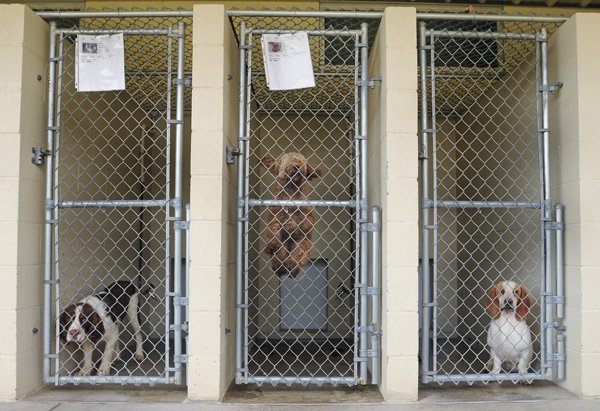ROGERS — Every day Bud Norman has to make a life-or-death decision. Norman is the manager of the Rogers Animal Shelter.
“I hate it when I have to decide which animals will have to be euthanized,” he said. “It breaks my heart.”
The Rogers shelter, which also serves as the shelter for Bentonville, is overflowing with animals. Designed for 50 dogs and about 30 cats, the shelter normally has 75 dogs and more than 40 cats.
“We been over capacity out here for more than a year, and I don’t see the overcrowding ending any time soon,” Norman said.
Norman said he, shelter employees and volunteers do everything in their power to see animals are adopted.
“Unfortunately our best isn’t always enough,” he said.
The Rogers Shelter isn’t the only shelter with overcrowding problems. The Springdale, Fayetteville and Benton County Humane Society shelters are facing the same challenge.
The Fayetteville Animal Shelter, which serves Fayetteville and the rest of Washington County, is normally overcrowded, said Justine Middleton, shelter superintendent.
“We get from 4,500 to 5,000 animals through here in a year. That’s considerably more than this facility is equipped to handle,” Middleton said.
Washington County is building its own shelter, which should help with the overcrowding, Middleton said.
Teresa Johnson, assistant superintendent, said the Springdale shelter has been at capacity for several months.
Clayton Morgan, director of the Benton County Humane Society, a nonprofit shelter, said the shelter has been overcrowded for several years.
“I’m here seven days a week,” Morgan said. “We have more animals than we have space, but we’ll keep accepting animals. That’s our job.”
Shelter professionals don’t agree on what is causing the overcrowding.
Morgan, Middleton and a spokesman from the American Society for the Prevention of Cruelty to Animals, said the overcrowding is because of the poor economy.
“I don’t have any data to back that up, nobody does, but I hear the same thing over and over again,” said Jodi Buckman, society senior director of community outreach. “People leave their animals when a house is foreclosed. People bring family pets to the shelter they can’t afford to feed or care because they are unemployed. Some people just abandon an animal they no long want or can afford. It’s a national tragedy.”
Norman has a different take on the situation.
“It’s because some people think of animals as Bic lighters — they’re disposable,” he said, shaking his head.
Animal shelters in Northwest Arkansas have a policy that animals be spayed or neutered before they are released for adoption.
Some states on the East Coast have mandatory spay and neuter programs for pet owners, Buckman said.
“In states with very active spay and neuter programs, most shelters have very few animals to care for,” Buckman said.
Rescue organizations are part of the solution, but the adoption program is the lifeblood of shelters.
“We work to see as many animals as possible find a good home,” said Morgan at the Benton County shelter. “Our adoption rate is about 60 percent, but I wish it were higher. These animals don’t deserve to die. They haven’t done anything wrong other than being born,” Morgan said.
Buckman said educating the public is key.
“Beside spay and neuter programs, shelters need to have an aggressive education program on pet adoptions,” Buckman said. “There are many fine animals available for adoption. Shelters need to advertise adoption programs and keep the pubic informed on what animals are available in the shelter.”
There are no hard and fast rules at the Rogers shelter on how long an animal can stay without being adopted.
“We keep an animal as long as we can and make every effort to send the animal to a rescue organization or find it a home,” Norman said. “Unfortunately, the city can’t afford to keep forever every animal that comes in here. At some point I have to make that hard decision of putting the animal down. That’s the worst part of this job.”

